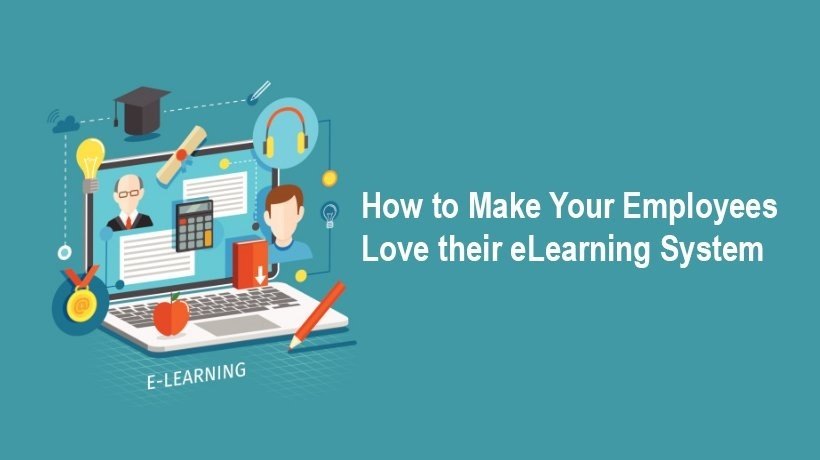How To Make Your Employees Love Their eLearning System: The Way To Learner Buy-In
A successful learning experience makes it much easier to both acquire knowledge and retain it. This success largely depends on the learning environment, and in 2016, this environment becomes increasingly electronic. In today’s $130 bn market for Training and Development (Deloitte), eLearning takes its share of $2.3 bn and growing (TalentLMS). With a Learning Management System (LMS) as a mediator, raising the adoption of corporate knowledge becomes the matter of learner buy-in of the system. With the stress of adopting another IT system and often overwhelming workloads, earning the audience for a Learning Management System is a task beyond ordinary, especially for optional and self-initiated courses. Meanwhile, if successfully integrated into the corporate learning landscape, a Learning Management System can contribute to multiple critical metrics – from increasing learners’ retention rate up to 60% (Shift) to growing revenue per employee and profit margins.
For the bottom line, this means a true business impact, let alone a justified investment in an IT solution. But how to get there?
Apart from engaging content, which we won’t cover here, the learner buy-in of a corporate Learning Management System depends primarily on its ease of use and functional value. As trainees have to make their way through unfamiliar interfaces to gain, check and review knowledge, reducing barriers to Learning Management System adoption is key to increasing the efficiency of corporate eLearning in general.
1. Usability
No employee wants to spend extra time on figuring out how to navigate course materials, submit assignments, and pass tests, especially in such time-sensitive contexts as onboarding or expiring certification. For example, an onboarding training course can last up to 90 days, so each interaction should be painless and aiming at efficiency. This means that the system has to meet end users’ expectations and reduce time required for orientation in the Learning Management System functionality.
To get an idea about how to make the interface highly usable and intuitive, it’s possible to survey end user groups directly, including their feedback in the LMS requirements. Another option is to get consulted by technological vendors who are known to provide the full cycle of eLearning software services, from UI/UX design to the back-end, and are familiar with capabilities and limitations of modern eLearning technologies and platforms. For example, PayPal chose to build their corporate educational portal on Moodle due to its broad reporting features and SCORM-compliant learning support.
A core part of any Learning Management System, content management shouldn’t be overlooked either. One of the most critical requirements is to make it easy and frictionless, so that users can upload, share, update, and edit multimedia content and its properties all without leaving the page or switching to other applications to continue working on a document.
If you’re not planning on a full-fledged mobile version of the Learning Management System, building a responsive interface will earn extra points with the system users who could switch effortlessly between screens.
2. Value-Added Features
Going beyond the out-of-the-box scope and introducing value-added features will work great in both directions – with learners and Learning Management System administrators. Backed up with real-life cases of eLearning adoption, the following has proved to facilitate Learning Management System buy-in in corporate settings:
Support Of Online And Offline Courses.
Limiting the Learning Management System scope only with online trainings would be short-sighted. On the contrary, bringing the organization’s entire spectrum of learning opportunities and managing them from a single system will help to consolidate a holistic view of all training activities, including offline face-to-face meetups and instructor-led trainings (ILT).
Single Sign-On Across Corporate Systems.
Simple yet effective, a single sign-on helps to reduce IT support efforts both on setting up new accounts and dealing with forgotten credentials in the long run. This feature also improves user experience and fosters learners’ satisfaction with the system.
Web Conferencing.
Whether an in-built Learning Management System feature or integrated from another corporate tool such as Skype for Business, web conferencing enables remote instructor-led trainings, group sessions and one-on-ones where physical presence is impossible or just not reasonable. This feature also helps to reduce footprint by saving resources and producing fewer emissions, which is among the paramount benefits of eLearning in general.
Multimedia Learning.
Video learning is claimed to be a fast-growing eLearning trend. This makes it a requirement to enable the Learning Management System with video streaming, where there is no longer a need to leave the application to view video materials. Podcasts are handy too, and so are embedded presentations.
Social Networking.
This feature will help to keep up with the standards set by ubiquitous social media, and also to block learners’ temptation to take a discussion elsewhere. Introducing a forum, team collaboration boards and chats is helpful both for individual and group work. Some ideas or assignments may be unclear, others may provoke a need to discuss or share a personal insight on the topic. Yet, frustration can be easily resolved if a learner can take to forums or collaboration boards to share it with fellow trainees and instructors. Over time, these social networking spaces can grow into treasure boxes of employee-generated knowledge and learning best practices.
Cross-System Integration.
Integrating the Learning Management System with other relevant business applications of the corporate infrastructure (employee database, onboarding portal, etc.) comes in handy for system administrators and instructors, who may want to pull necessary data from other corporate sources. For this, it’s also worth making it a matter of a few clicks to export or import Learning Management System data.
3. Users First
At all the stages of planning a Learning Management System rollout, it’s necessary to think of end users who are in the position to make it or break it. As eLearning is still largely an area of pioneers, stepping into it cautiously also means looking at related technologies for inspiration and guidance. It’s necessary to remember that learners’ expectations are largely shaped by widely available MOOCs and social networking websites. So as they come equipped with their own preconceptions, a corporate Learning Management System needs to stand the test of learner buy-in.
This brief overview gave a head start on how to make a Learning Management System popular with corporate learners by means of usability and value-added features. Both draw on best practices in software development and IT consulting, with an eye on making the system bring positive ROI and contribute to business growth. Even as each company tailors Learning Management System requirements to its own corporate specifics, these must-have elements can serve as pillars of building an adoptable, effective eLearning solution.









